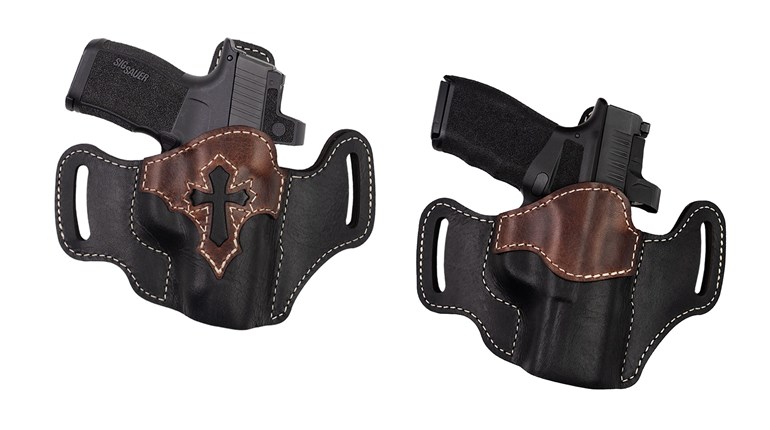
There are a ton of factors that enter into deciding what holster to buy. Size, shape, design. Will it be IWB or OWB? What about convertible holsters that can do both? Aside from aesthetics and whether I'm concealing or open carrying (which I do very sparingly and only under certain conditions), there are three criteria that I think are essential in whatever holster I choose:
- It must hold the gun securely.
- It must cover the trigger and trigger guard completely.
- It must allow one-handed reholstering.
What material you choose for your holster can determine how well it checks off these three boxes. The two most common materials are leather and Kydex, two very different substances that perform quite differently in daily use. So, let's start our comparison of leather vs Kydex holsters by going old school and work toward more modern offerings.
Leather

The first contestant in the Leather vs. Kydex holster bout is leather. Nothing beats a piece of fine leather. It smells good, looks good, and brings back memories of the good ol' days, even if you weren't alive back then. You've seen all the movies. There's just something about a leather holster that screams nostalgia. Leather has been the holster material of choice since the Wild West. They were typically made from cowhide, horsehide, or even buffalo hide.
For many applications, leather can be a fine choice. However, for all its great look and feel, it does have some limitations. One reason leather smells and feels so good is that it is a natural material, which means that it begins to wear over time. This wear can form a nice patina for a customized look that adds to the craftsmanship, but it can also violate the three rules of a good holster, especially for IWB applications.
A brand-new leather holster will be tight enough to hold the gun securely. Some new leather holsters are so tight that putting the gun away can be challenging. Over time and with some work, the cavity opens up and receives the gun. However, the holster's shape will continue to morph over time to the point where the gun is no longer secure and could easily fall out.
Because leather is malleable, it is less than ideal for inside the waistband (IWB) carry, where the pressure from the waistband can close the holster's mouth when the gun is removed, making it nearly impossible to reholster the firearm one-handed safely. Some holster makers have answered this complaint by inserting either Kydex (see below) or carbon fiber material between the leather layers to add strength to the shape.
Kydex

The second contestant in the leather vs. Kydex holster faceoff is Kydex. You may not realize it, but you see Kydex outside of the gun world all the time. It is a commonly used polymer for many applications, such as overhead bins on airplanes. In addition, some car makers use it for parts of the dashboard. Manufacturers love it because it is moldable and keeps its shape after decades of use.
These characteristics make it a great material for holsters. Because it is so easily moldable, it can be shaped for any gun on the market. The moldability adds to the holster's security, keeping the gun snuggly inside until ready to draw. In addition, many Kydex holster makers will shape in an audible click that tells the user the gun is locked into place and properly seated inside.
Kydex holsters do not require any break-in period, as their shape is already set from the start. And, they will not lose their shape over time from regular use. The intrinsic strength of Kydex keeps the mouth of the holster open all the time, so reholstering, especially in IWB applications, is safer and does not require your support hand to open the top to insert the firearm.
One downside to Kydex is its biggest complaint among users: comfort. Not everyone wants a stiff, plastic holster digging into their skin all day. This is not a widespread issue, but it does pop up every once in a while, among Kydex users. An easy solution is to wear a t-shirt to cushion the rubbing or reposition the holster in a spot that doesn't dig in so much.
Hybrid Holsters

For those who are not strongly in either camp, fret not, for there is a compromise with using a leather vs a Kydex holster: the hybrid holster. Typically consisting of a Kydex outside shell fastened to a leather backer, the hybrid combines the best of both worlds. Most hybrid holster buyers are drawn to the retention and ease of use of the Kydex and the comfort of the softer leather backer that doesn't pinch or bite the skin during everyday wear.
But, like the other teams in the leather vs. Kydex holster game, hybrids are not perfect. There are two major factors to consider about hybrids. First, because the backer is leather, it will begin to reshape itself over years of repeated use, reducing the security factor a bit. Second, the leather is affected by weather, especially hot weather, where you'll likely be sweating a lot. Moisture can alter the shape of the leather and break it down over time.
Leather vs Kydex Holsters: Is There A Winner?
At the risk of sounding like a politician, there is no clear-cut winner in the leather vs. Kydex holster contest. Each has its good points and bad points. It boils down to personal preference. Which do you prefer? Have you tried them both? What are your thoughts?



































